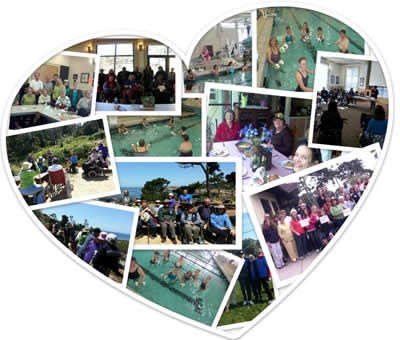Managing Spasticity: stretching, Medication, CBD
Published by Everyday Health
 A number of steps can be taken to address spasticity and limit its debilitating effects.
A number of steps can be taken to address spasticity and limit its debilitating effects.
In fact, the NMSS notes that it’s important to treat spasticity proactively to avoid certain complications, such as contractures (frozen or unmovable joints) and pressure sores, in which skin becomes irritated, sensitive, and even damaged after extremities are left in the same position for too long.
Stretching
According to Sandoval, a regimen of regular stretching of your arms and legs is probably the most important treatment for spasticity.
“In cases of mild spasticity, that may be all that you need,” he says. But if spasticity or other symptoms make it difficult to stretch your muscles on your own, he recommends working with a physical therapist or health aid.
“Your spouse or a family member can also help,” he notes.
For Ciganovich, exercising and stretching every day has kept her spasticity under control.
“There are a lot of days I don’t feel like going to the gym, but I push myself,” she says. “I always feel better when I do my stretching and exercise, and even on the worst days, my MS symptoms practically disappear.”
Muscle Relaxants
In cases of moderate to severe spasticity, your doctor may prescribe a muscle relaxant, a drug designed to loosen tightened muscles.
Most often with MS, the drug baclofen is used for this purpose. Baclofen is usually administered in pill form, but a small percentage of people with MS may need to have a baclofen pump surgically implanted. The pump, which is shaped like a hockey puck and is implanted in the abdomen, is designed to deliver the drug via a catheter to the spinal cord.
“Baclofen has significant side effects, which can limit its effectiveness,” Sandoval says. “It can make you sleepy or groggy, which could be a problem if you have to drive or go to work, and in some cases it has been known to make people nauseated. The baclofen pump greatly minimizes those side effects because it delivers the drug directly to the spinal fluid that surrounds the spinal cord. However, inserting the pump is an invasive procedure.”
Botox
Your doctor may also recommend Botox (onabotulinumtoxinA) injections to specific muscles. These injections temporarily weaken the spastic muscle, which allows some improvement of function and reduction of painful spasms.
“I recently started getting Botox injections in my neck and shoulder areas to manage the pain,” notes Ciganovich. “However, when the muscles are treated with the Botox, it makes it harder to work out. So I try and fight the pain and keep going.”
Cannibidiol (CBD)
There are currently no CBD-based medicines for spasticity approved by the U.S. Food and Drug Administration (FDA). Nonetheless, as more and more U.S. states pass laws allowing for the use of cannabis and its pharmaceutical derivatives for medical purposes, researchers are investigating its potential uses in MS, specifically for the management of symptoms like pain and spasticity. An example of a CBD already being used to treat these symptoms in MS is Sativex (nabiximols), a cannabinoid spray approved in Canada and some European countries for use as a complement to prescription medication.
Sativex spray combines two chemicals found in many cannabis plants — CBD and tetrahydrocannabinol (THC) — to treat spasticity by working to balance out receptors found in multiple organs and tissues throughout the body. A review of existing research published in February 2018 in the journal Current Neurology and Neuroscience Reports found that of 10 “moderate to high quality” clinical trials, five “concluded that there was sufficient evidence that cannabinoids may be effective for symptoms of pain and/or spasticity in MS.”
In addition, a study published in November 2016 in the journal European Neurology found that among 281 people with MS spasticity who used the Sativex spray for three months (at a mean dosage of six sprays per day) spasticity and spasticity-related symptoms (muscle spasms, fatigue, pain, sleep quality, and bladder dysfunction) were significantly improved.
CBD is also available in oils and lotions for topical (on the skin) applications.
“I have tried the CBD oils and creams for my legs and it seems to work,” Ciganovich says. “I think any type of treatment for MS should be allowed if it works for that person, because MS is difficult to live with and there’s no cure.”
“In general, the data on the use of CBD and other forms of marijuana to treat symptoms like spasticity is limited and very mixed,” adds Vijayshree Yadav, MD, clinical director of the Multiple Sclerosis Center at Oregon Health and Science University in Portland, who published her own review in March 2014 in the journal Neurology on the topic. “And much of what we have is subjective — meaning it’s based on people self-reporting improvement in symptoms — as opposed to measurable, objective criteria. We are seeing more and more people experimenting with marijuana and its derivatives, but not everyone is seeing benefit.”
As with any potential new treatment, Dr. Yadav recommends talking to your doctor before trying CBD or other marijuana-based products.
Disclaimer: Content on our site is provided for information purposes only; therefore, this material is not intended to advise. This information includes a link to a site that is maintained by another; MS Monterey is not responsible for content on this site. Please remember to consult with your doctor or health care provider before making any changes to your medication(s) or medical regimen.

